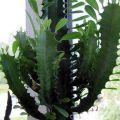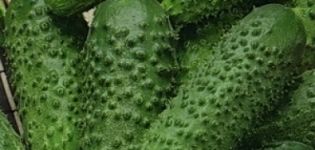Description of the 7 best types of indoor milkweed, reproduction and care
Milkweed is a decorative deciduous flower that is often grown to decorate rooms. Even inexperienced flower growers can grow it, since the plant is unpretentious in care. However, all the same, before planting, you need to figure out all the features of planting and caring for indoor milkweed.
Popular varieties of milkweed
Euphorbia has many varieties that can be grown at home. Therefore, before planting this cactus, you need to find out which varieties are better to plant.
Ribbed or comb
It is a green stem shrub with a ribbed stem. The height of the comb variety is one and a half meters. The plant is most commonly found in coastal and subtropical forest areas in Madagascar.
Over time, miniature yellowish flowers form on the bush. The diameter of each of them does not exceed three centimeters. Ribbed spurge blooms in the first half of summer. Flowering lasts 20-30 days. Among the main features of the ribbed plant are frost resistance, as well as protection against pests.
Belozhilkovy
It is considered one of the most common varieties of milkweed, which is grown by many flower growers. In nature, such a plant grows up to two meters without problems. Indoors and in a pot, the maximum height is 120-130 centimeters. The trunk of the white-veined variety also has irregularities on the surface. The foliage is painted in a bright green color with thin white veins.
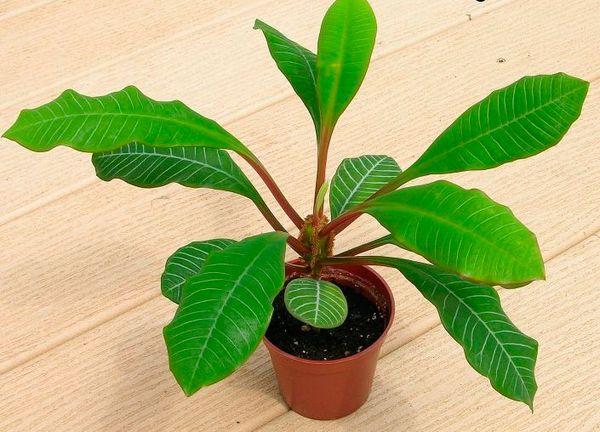
The flowers of such a seedling are not easy to notice, since they are located under the leaves. They have yellowish petals and bloom in June or July.
Mile
It is a tall variety that grows up to two and a half meters under suitable conditions. The shrub has many grayish branched stems. The leaves are located at the top of the shoots. Their length reaches four centimeters and their width does not exceed two centimeters.
The main distinguishing feature of Mili is considered to be the bracts, which are brightly colored. Their surface can be painted yellow, orange and scarlet. The flower is found in small orange inflorescences.Mila blooms, like most other varieties, in summer.
Medusa's head
Decorative medium-sized spurge that grows well in pots. If you properly care for the planted seedling, its height will reach 130-145 centimeters. In this case, the diameter of the main stem is 20-25 cm.
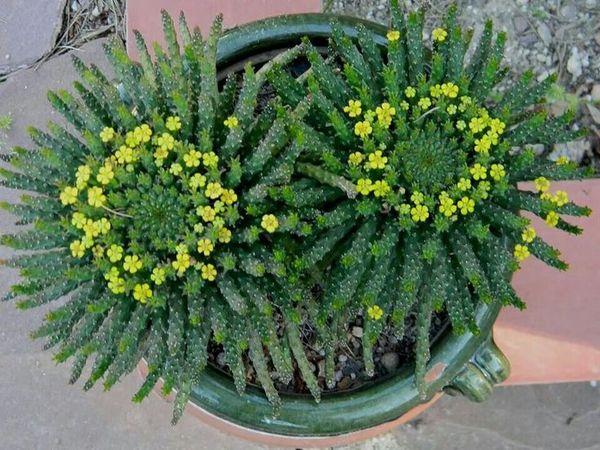
The jellyfish variety has many lateral branches on the trunk, which can be both short and long. The central part of the trunk is slightly thickened, it accumulates nutrients and moisture, which comes through the root system from the soil. Medusa's head blooms in late May or early June.
Prettiest or poinsettia
A popular blooming spurge, which is common in central America and southern Mexico. This variety is considered one of the most compact, since the bush grows up to fifty centimeters. On the stems of the shrub, greenish leaves are formed, which have an elliptical shape. On the edges of each of the leaves there are jagged edges that make the leaves more unusual.
The distinctive features of this milkweed include its unusual flowers, which can be painted in any color. Plants with red, yellowish or burgundy petals are most often found.
Enopla
A succulent undersized plant that can be grown in small pots. Enopla bushes grow up to 30-35 centimeters, small red thorns with a slight purple tint grow on the main stem. On the stems, miniature reduced leaves with a green surface are formed.
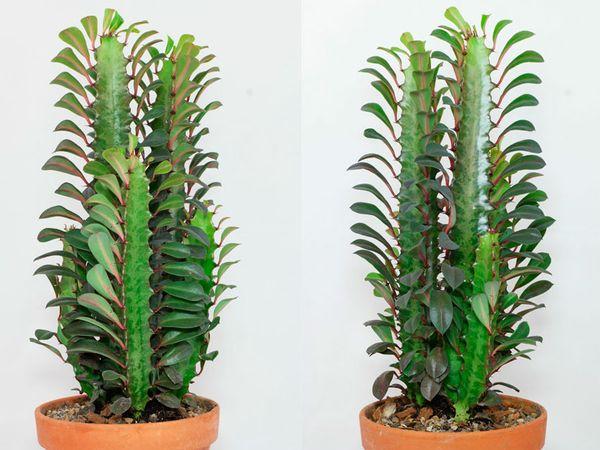
Flowers of two types are formed on the plant:
- male;
- female.
Enopla bloom begins in the summer and lasts 2-3 weeks.
Fat
This plant species looks like a small cactus. The fat seedling has a spherical shape. Leaves or thorns do not form on it; instead, compact branches in the form of spheres appear on the plant. The diameter of the main stem is 5-8 centimeters, and the height is 15-30 cm. At first, the trunk is octagonal, but over time its shape becomes more rounded.
Fat spurge can be gray, greenish, steel, purple and even brown. Also on its stem, you can see transverse multi-colored stripes.
Can I keep it at home?
Some people are afraid to keep euphorbia at home, as its juice contains toxic substances that can harm human health. However, if the bush is properly maintained, it can be grown at home.
Experienced flower growers recommend handling the planted milkweed carefully. You must adhere to the following recommendations:
- transplant seedlings with protective gloves;
- install pots with a plant out of the reach of children and animals;
- do not pick off the stems with bare hands.
Useful properties of milkweed
Euphorbia is classified as a plant that is actively used in medicine. From its juice, you can prepare medicinal compositions that have anti-inflammatory, analgesic and diuretic properties. Fresh juice contains the following components:
- zuphorbon;
- saponin;
- alkaloids.
Also in the flowers of the plant are useful enzymes that improve the functioning of the immune system and help get rid of the symptoms of leukemia. Euphorbia can be used to treat wounds and heal ulcers.

What to consider before purchasing a flower
Before purchasing a flower, you need to familiarize yourself with the conditions in which it is best to grow it.
Location and illumination
Growing milkweed seedlings should be carried out in a suitable place for this. Many varieties of this plant are photophilous and therefore must be grown on windowsills, which are exposed to direct sunlight.However, the finest variety is more fond of diffused lighting and therefore care must be taken to ensure that no rays from the sun fall on it.
Such a plant can also be grown in a shaded place, where the light practically does not enter. In this case, the leaves will have a less bright color, which is why they will lose their attractiveness.
Optimal temperature conditions
When growing euphorbia, one must adhere to the temperature regime, which promotes plant growth. Experts advise growing it at temperatures between 15 and 27 degrees above zero. In the summer, the plant is carried outside, under the sun. In the evening, when the temperature drops below 14-16 degrees, he is brought into the room.
There are varieties of milkweed that can tolerate temperature changes. They can grow at a temperature of 5-7 degrees. However, with such temperature indicators, the container with a flower must be placed in a lighted place.
Humidity
Some believe that the euphorbia bush must be grown in high humidity conditions, but this is not the case. The plant tolerates drought, and therefore the humidity level in the room with milkweed should be medium. However, the plant will grow well even with high humidity.
Required soil composition
Before planting euphorbia, you should figure out the optimal composition of the soil. It is the soil and the components that make up it that affect the further development of the planted bush.
Florists with many years of experience recommend growing seedlings in permeable and loose substrates. Such land is ideal for growing milkweed. If it was not possible to purchase a soil mixture for succulent-type plants, you can independently prepare a composition for growing cactus plants. For this, sand is mixed with humus and soil in equal quantities.
Pot size
In order for the planted spurge to grow well, you need to choose a suitable container for it. Some people use boxes for planting milkweed, but most often people use pots. In this case, the containers must be changed as the plant grows. Experts advise replacing the pot annually.

First, the seedlings are planted in small pots 10-12 centimeters deep. However, when the root system grows, larger containers will have to be prepared. Adult milkweed seedlings should be grown in pots, the depth of which is 17-25 centimeters.
How to care for a flower at home
The planted milkweed needs proper care so that it develops and blooms faster.
Regularity of watering
Such a plant, like many others, must be watered periodically. At the same time, it is not necessary to engage in soil moistening too often, even in severe droughts. In the summer, watering is carried out no more than once a week. In winter, the amount of watering is reduced to several times a month. With temperature indicators less than twelve degrees, watering the seedlings is contraindicated.
If you have to moisten overdried soil, this should be done gradually. First, spraying is carried out and only after that watering.
Top dressing
Experts advise regularly adding fertilizers to the soil so that the plant has enough nutrients. In this case, most of all the seedling must be fed when the growing season begins. In this case, fertilizing mixtures are added to the ground within two weeks.
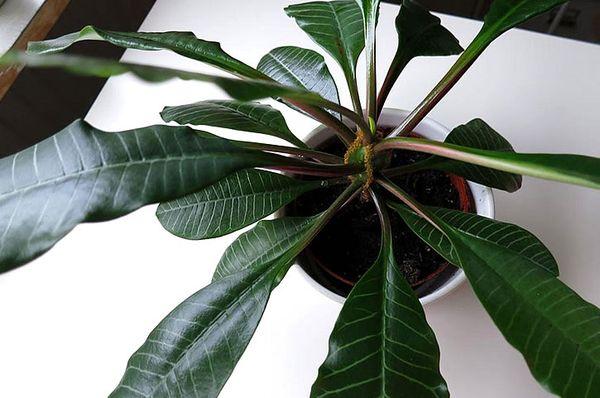
Euphorbia should not be fed with mixtures that contain a lot of nitrogen. This component can negatively affect the growth of the main stem of the seedling. Rotted compost or birch charcoal is considered the best top dressing.
Pruning and shaping the crown
Indoor bush spurge should be periodically trimmed and thinned to get rid of excess processes. Pruning also speeds up the growth of the main stem of the seedling at times. This procedure is carried out annually so that the milkweed does not have many side shoots.
You can trim the seedling with sharpened scissors or a knife. It is impossible to pick off the shoots manually, so as not to damage the euphorbia and not to cut yourself with your hands on the sharp thorns that grow on the stems.
Transfer
Transplanting milkweed is mandatory, since without transplanting it will not grow normally. Florists advise to transplant the seedling into a larger pot with thick walls, the diameter of which is 3-4 centimeters.
Before planting the plant in a new place, the bottom of the container is covered with expanded clay for better drainage. The thickness of the drainage layer should not be more than five centimeters. Planting of euphorbia bushes in a new place is carried out annually.

Pests and diseases: control and prevention
Despite the fact that the plant is resistant to some negative influences, it still sometimes gets sick and is attacked by pests. Saplings begin to hurt due to the following reasons:
- lack of fertilizers;
- lack of light;
- non-compliance with the temperature regime;
- excess moisture.
The presence of pests or diseases is indicated by yellowing of the foliage, the appearance of spots on the leaf plate, wilting of seedlings. Fungicidal preparations and pest control agents will help protect the spurge.
How to propagate spurge
There are three breeding methods for euphorbia seedlings.
Cuttings
Some gardeners propagate euphorbia bushes by cuttings. For this, a leaf is pinched off from the plant, which is sprinkled with "Kornevin". This is done to stimulate the growth of the rhizomes and to root them. After that, the cutting is transferred to a container with sand and left for 20-35 days.

Dividing the bush
Also, spurge reproduces not only by the cuttings, but also by the usual division of the bush. Such breeding is carried out in March and early April. The bush is carefully dug up, after which the stems are separated. Then the separated stems with roots are transplanted to a new place.
Seeds
Globular plant varieties reproduce only by seed. Seed material is calcined in an oven before planting, after which it is planted in the prepared soil mixture. After 40-50 days, the germinated seedlings are transplanted into a larger pot.
Conclusion
Flower lovers often plant indoor spurge. However, before that, you need to understand the varieties of the plant and the features of caring for it.



